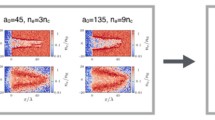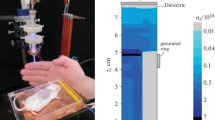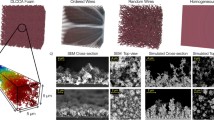Abstract
Using cold atmospheric plasma (CAP) could promise a breakthrough in the fight against cancer cells, providing an alternative to surgical and chemical therapies. Here, the reduction rate of the temperature of plasma nanosphere is simulated and studied after the injection of electromagnetic waves into it. For this purpose, the plasma nanosphere is irradiated by a laser beam with Gaussian profile and the variation rate of the temperature is investigated. Diagrams of the variation rate of the plasma temperature are presented in terms of some parameters such as the plasma frequency, the radius of the plasma nanosphere, the wavelength of the laser beam, the temperature of the electrons, the relative distance between the front mirror of laser structure and nanosphere center as well as the position of the beam waist center with respect to the center of the nanosphere. In this regard, the temperature of the plasma nanosphere can be reduced by laser irradiation, thus observing the cooling of the plasma. These calculations are performed for the plasma in the collisional approximation. The results obtained can be potentially employed for designing a new type of CAP-based cancer treatment, being useful for the destruction of cancerous tissues and the delivery of drugs to them.
Graphic abstract











Similar content being viewed by others
Data Availability Statement
References
T. Kondo, Elucidation of mechanism of apoptosis induced by cold atmospheric plasma toward to cancer therapy. Sensitization by physical and chemical modalities. Purazuma Kaku Yugo Gakkai-Shi 97(3), 129–133 (2021)
M. Keidar, Plasma for cancer treatment. Plasma Sources Sci. Technol. (2015). https://doi.org/10.1088/0963-0252/24/3/033001
E. Stoffels, I.E. Kieft, R.E.J. Sladek, L.J.M. Van den Bedem, E.P. Van der Laan, M. Steinbuch, Plasma needle for in vivo medical treatment: recent developments and perspectives. Plasma Sources Sci. Technol. 15(4), 169–180 (2006). https://doi.org/10.1088/0963-0252/15/4/S03
M. Laroussi, M.G. Kong, G. Morfill, W. Stolz, Plasma Medicine (Cambridge University Press, 2014). https://doi.org/10.1017/CBO9780511902598
A. Fridman, G. Friedman, Plasma Medicine (Wiley, 2013)
M. Keidar, I.I. Beilis, Plasma Engineering Applications from Aerospace to Bio and Nanotechnology (Elsevier, 2013)
G. Fridman, G. Friedman, A. Gutsol, A.B. Shekhter, V.N. Vasilets, A. Fridman, Applied plasma medicine. Plasma Process. Polym. 5, 503–533 (2008). https://doi.org/10.1002/ppap.200700154
J. Tornin, C. Labay, F. Tampieri, M.P. Maria-Pau Ginebra, C.C. Cristina, Evaluation of the effects of cold atmospheric plasma and plasma-treated liquids in cancer cell cultures. Nat. Protoc. 16, 2826–2850 (2021). https://doi.org/10.1038/s41596-021-00521-5
K. Torii, S. Yamada, K. Nakamura, H. Tanaka, H. Kajiyama, K. Tanahashi et al., Effectiveness of plasma treatment on gastric cancer cells. Gastric Cancer 18(3), 635–643 (2015). https://doi.org/10.1007/s10120-014-0395-6
N. Hattori, S. Yamada, K. Torii, S. Takeda, K. Nakamura, H. Tanaka et al., Effectiveness of plasma treatment on pancreatic cancer cells. Int. J. Oncol. 47, 1655–1662 (2015). https://doi.org/10.3892/ijo.2015.3149
A.A. Rukhadze, A.F. Alexandrov, L.S. Bogdankevich, Principles of Plasma Electrodynamics, 2nd edn. (Urss, Moscow, 2013)
N.A. Krall, A.W. Trivelpiece, Principles of Plasma Physics (McGraw-Hill, 1973)
V.E. Golant, A.P. Zhilinsky, I.E. Sakharov, S.C. Brown, Fundamentals of Plasma Physics (Wiley, New York, 1980)
A.I. Akhiezer, I.A. Akhiezer, R.V. Polovin, A.G. Sitenko, K.N. Stepanov, Plasma Electrodynamics: Linear Theory (Pergamon, 1975)
Y. Kazakov, D.V. Eester, J. Ongena, Plasma heating in present-day and future fusion machines, in 12th Carolus Magnus Summer School on Plasma and Fusion Energy Physics (2015)
H. Huang, C. Dai, H. Shen, M. Gu, Y. Wang, J. Liu, L. Chen, L. Sun, Recent advances on the model, measurement technique, and application of single cell mechanics. Int. J. Mol. Sci. 21(17), 6248 (2020). https://doi.org/10.3390/ijms21176248
I.S. Amiri, J. Ali, Nano optical tweezers generation used for heat surgery of a human tissue cancer cells using add/drop interferometer system. Quantum Matter 2(6), 489–493 (2013). https://doi.org/10.1166/qm.2013.1087
Y. Tan, A.Y.H. Leung, K. Wang, T. Fung, D. Sun, Optical tweezer technology. IEEE Nanatechnol. Mag. 5(1), 17–21 (2011). https://doi.org/10.1109/MNANO.2010.939832
G. Hong-Lian, L. Chun-Xiang, D. Jian-Fa, J. Yu-qiang, H. Xue-hai, L. Zhao-lin, C. Bing-Ying, Z. Dao-zhong, Mechanical properties of breast cancer cell membrane studied with optical tweezers. Chin. Phys. Lett. 21(12), 2543 (2004). https://doi.org/10.1088/0256-307X/21/12/062
M. Rasouli, N. Fallah, K. Ostrikov, Lung cancer oncotherapy through novel modalities: gas plasma and nanoparticle technologies. IntechOpen (2022). https://doi.org/10.5772/intechopen.92053
Z. He, K. Liu, E. Manaloto, A. Casey, G.P. Cribaro, H.J. Byrne et al., Cold atmospheric plasma induces ATP-dependent endocytosis of nanoparticles and synergistic U373MG cancer cell death. Sci. Rep. 8, 5298 (2018). https://doi.org/10.1038/s41598-018-23262-0
X. Cheng, W. Murphy, N. Recek, D. Yan, U. Cvelbar, A. Vesel et al., Synergistic effect of gold nanoparticles and cold plasma on glioblastoma cancer therapy. J. Phys. D Appl. Phys. 47, 335402 (2014). https://doi.org/10.1088/0022-3727/47/33/335402
N.Bleistein, Mathematics of modeling, migration and inversion with Gaussian beams, in European Association of Geoscientists & Engineers (2008). https://doi.org/10.3997/2214-4609.201405084.
D.S. Simon, A Guided Tour of Light Beams, from Lasers to Optical Knots (Morgan & Claypool Publishers, 2016). https://doi.org/10.1088/978-1-6817-4437-7
J.A. Lock, P. Laven, Co-polarized and cross-polarized scattering of an off-axis focused Gaussian beam by a spherical particle. 1. Exact GLMT formalism. J. Quant. Spectrosc. Radiat. Transf. 221, 260–272 (2018). https://doi.org/10.1016/j.jqsrt.2018.08.029
X. Liu, G. Shan, J. Yu, W. Yang, Z. Ren, X. Wang, X. Xie, H. Chen, X. Chen, Laser heating of metallic nanoparticles for photothermal ablation applications. AIP Adv. 7(2), 66 (2017). https://doi.org/10.1063/1.4977554
S. Malek, R. Poursalehi, The effects of laser wavelength and particle size on heating and melting of gold nanoparticles dispersed in liquid. Sci. Iran. Trans. Nanotechnol. 23(3), 1489–1495 (2016). https://doi.org/10.24200/SCI.2016.3912
H.S. Shuichi, D. Werner, U.T. Takayuki, Studies on the interaction of pulsed lasers with plasmonic gold nanoparticles toward light manipulation, heat management, and nanofabrication. J. Photochem. Photobiol. C 13, 28–54 (2012). https://doi.org/10.1016/j.jphotochemrev.2012.01.001
G. Baffou, Gold nanoparticles as nanosources of heat. Photoniques (2018). https://doi.org/10.1051/photon/2018S342
B. Fasla, R. Benmouna, M. Benmouna, Modeling of tumor’s tissue heating by nanoparticles. J. Appl. Phys. 108, 124703 (2010). https://doi.org/10.1063/1.3525089
J. Shao, R.J. Griffin, E.I. Galanzha, J.W. Kim, N. Koonce, J. Webber, T. Mustafa, A.S. Biris, D.A. Nedosekin, V.P. Zharov, Photothermal nanodrugs: potential of TNF-gold nanospheres for cancer theranostics. Sci. Rep. 3(1293), 66 (2013). https://doi.org/10.1038/srep01293
F. Khosravi, B. Jazi, A. Abdoli-Arani, Simulation of Gaussian electromagnetic wave interaction and its effect on the dynamics of metallic nanosphere (repulsion or even elasticity). Eur. Phys. J. Plus 137(1), 139 (2022). https://doi.org/10.1140/epjp/s13360-021-02324-9
R.C. Davidson, Theory of nonneutral plasmas (W. A. Benjamin, 1974)
L. Valkunas, D. Abramavicius, T. Mančal, Molecular Excitation Dynamics and Relaxation: Quantum Theory and Spectroscopy (Wiley, 2013). https://doi.org/10.1002/9783527653652
Callen J.D. (2006). Fundamentals of Plasma Physics. University of Wisconsin.
J.A. Stratton, Electromagnetic Theory (Wiley/IEEE Press, 2007). https://doi.org/10.1002/9781119134640
G. Gouesbet, G. Gréhan, Generalized Lorenz–Mie Theories (Springer, Berlin, 2011). https://doi.org/10.1007/978-3-642-17194-9
F.J. Duarte, Tunable Lasers Handbook (Academic Press, 1995). https://doi.org/10.1016/B978-0-12-222695-3.X5000-4
Author information
Authors and Affiliations
Corresponding author
Appendix A
Appendix A
As can be seen in formulas (7–9), the coefficients \(c_{n}^{{{\text{pw}}}}\) (pw for plane wave) are isolated because they appear in the Bromwich formulation of the pure LMT. They are given by:
It allows to disconnect the \(c_{n}^{{{\text{pw}}}}\)’s and the \(g_{n}^{m}\)’s (n from 1 to infinity, and m from − n to n). Also, the generalized Legendre functions have been used in formulas (7–9) which are introduced as:
Generalized Legendre functions \(\tau_{n}^{1}\) and \(\pi_{n}^{1}\) identify with usual Legendre functions of the LMT, namely τn and πn, respectively.
The basic solutions of the spherical Bessel equation for n given are four spherical Bessel functions that denoted by \(\psi_{n}^{\left( i \right)} ,{ }i = 1,2,3,4\) as follows:
in which J and H(2) are the ordinary Bessel functions and Hankel functions of the second kind, respectively.
Here, the size parameter α and the optical size parameter β are introduced by:
in which λ is the wavelength in the surrounding medium.
Rights and permissions
About this article
Cite this article
Khosravi, F., Jazi, B. & Abdoli-Arani, A. The plasma nanosphere cooling rate simulation in the presence of the coherent electromagnetic waves with Gaussian profile. Eur. Phys. J. D 76, 96 (2022). https://doi.org/10.1140/epjd/s10053-022-00422-6
Received:
Accepted:
Published:
DOI: https://doi.org/10.1140/epjd/s10053-022-00422-6




